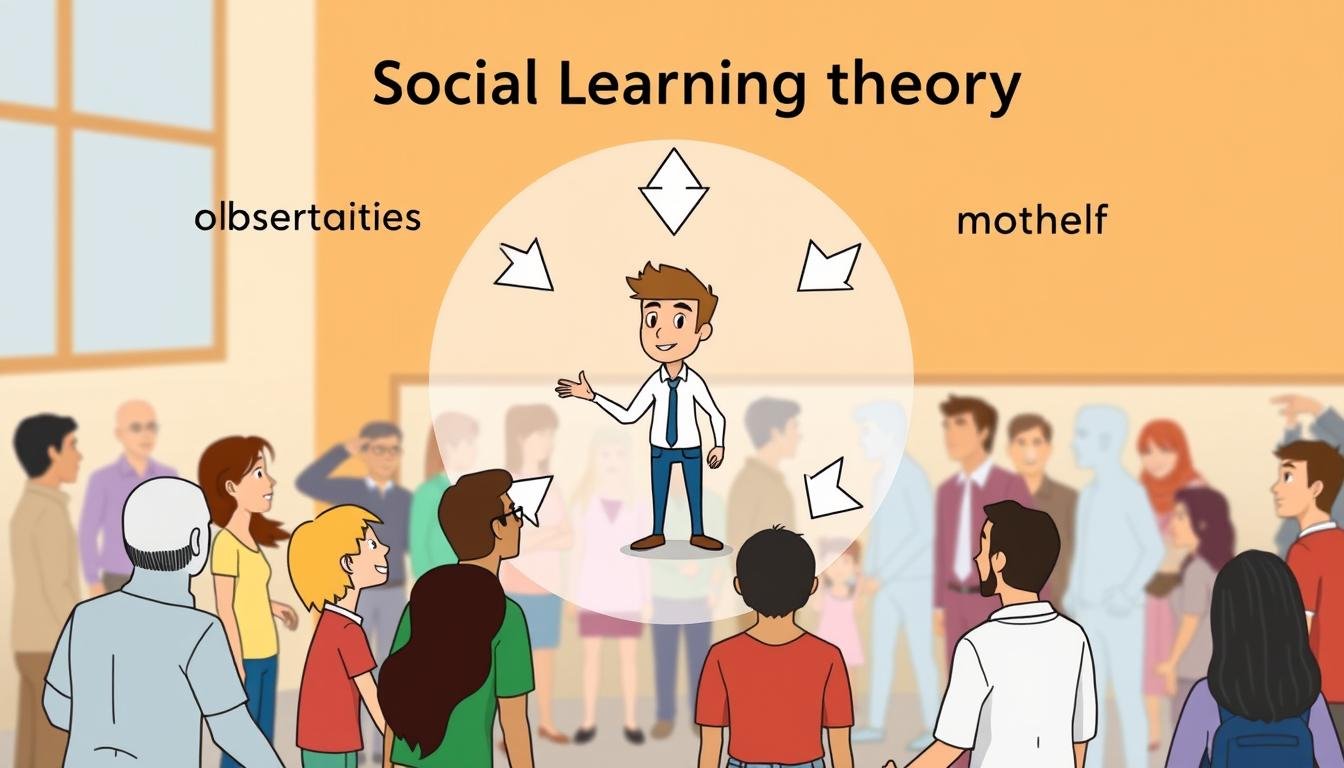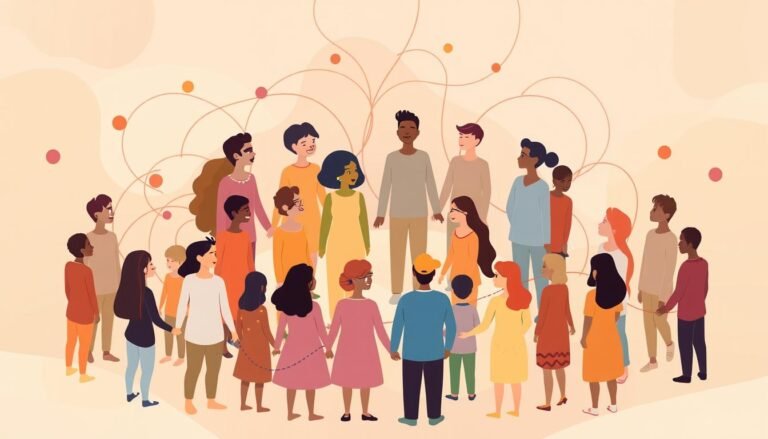Social Learning Theory: Understanding Behavior
Have you ever wondered why kids often copy their parents’ actions, both good and bad? This interesting phenomenon is at the core of Social Learning Theory. It’s a groundbreaking way to understand human behavior.
Psychologist Albert Bandura introduced Social Learning Theory. It says we learn not just by doing things ourselves, but also by watching and copying others. This idea connects behavioral and cognitive theories. It shows how outside influences and our thoughts work together.
The theory says we can learn new things and behaviors just by watching others. This is called modeling. It has big implications for understanding learning in places like schools and workplaces.
Bandura’s famous Bobo doll experiment showed kids imitate aggressive acts they see in adults. This discovery changed how we see learning and growth. It showed how much social influences can shape our actions.
As we dive into Social Learning Theory, we’ll look at its main parts, how it’s used in real life, and its impact on our daily lives. Whether you teach, parent, or just want to know more about people, this theory offers deep insights into learning and social interactions.
Introduction to Social Learning Theory
Social Learning Theory was introduced by Albert Bandura in 1963. It changed how we see human behavior and learning. This theory shows how we learn by watching and imitating others.
Definition and Core Concepts
At its heart, Social Learning Theory says we learn new behaviors by watching others. It focuses on four main parts: attention, retention, reproduction, and motivation. These parts help us learn from our surroundings.
Historical Background
The roots of Social Learning Theory go back to the early 20th century. Social psychologists studied group behavior and leadership. Their work helped Albert Bandura develop his groundbreaking theory.
Albert Bandura’s Contribution
Bandura’s famous Bobo Doll Experiment in the 1960s showed how kids learn aggressive behaviors by watching. This study showed the power of observing others. Bandura also introduced key ideas like self-efficacy and reciprocal determinism.
| Concept | Definition | Impact |
|---|---|---|
| Self-efficacy | Belief in one’s ability to succeed | Influences motivation and perseverance |
| Vicarious Experience | Learning by observing others | Shapes behavior without direct experience |
| Reciprocal Determinism | Interaction between person, behavior, and environment | Explains complex social learning processes |
Social Learning Theory is used in many areas, like education and workplace training. It helps us understand how we adapt to new cultures and learn from role models. By grasping these ideas, we can better navigate our social world and help others learn effectively.
The Four Key Processes of Social Learning Theory
Social Learning Theory, created by Albert Bandura, outlines four key processes for learning through observation. These processes help us understand why we learn certain behaviors and not others.
The first process is attention. It’s about focusing on the actions we see. How well we pay attention affects what we learn.
Retention is the second process. It’s about remembering what we’ve seen. Without remembering, we can’t do what we’ve observed later.
The third process is reproduction. This means we can actually do what we’ve seen. Just watching and remembering isn’t enough; we must be able to do it ourselves.
Motivation is the final process. It’s our desire to imitate what we’ve seen. We’re more likely to do something if we think it’s good or rewarding.
| Process | Description | Example |
|---|---|---|
| Attention | Focusing on the modeled behavior | Watching a chef prepare a dish |
| Retention | Remembering the observed behavior | Recalling the chef’s cooking steps |
| Reproduction | Performing the observed behavior | Cooking the dish at home |
| Motivation | Will to imitate the behavior | Desire to impress friends with cooking skills |
These four processes together create a complex learning experience. They show how learning and behavior are more than simple reactions. They reveal the detailed nature of how we learn and behave.
Observational Learning: The Heart of Social Learning Theory
Albert Bandura’s Social Learning Theory centers on observational learning. It shows how we learn new behaviors by watching others. This idea changed how we see human learning and social actions.
The Bobo Doll Experiment
Bandura’s Bobo doll experiment showed the power of imitation. Kids who saw adults being aggressive were more likely to act the same way. This study showed how easily people, especially kids, can learn from what they see.
Types of Modeling
Bandura found three main ways we learn through observation:
- Live model: Learning by watching real people
- Verbal instructional model: Learning from descriptions and explanations
- Symbolic model: Learning from media, books, or online content
Implications for Behavior Acquisition
Observational learning affects how we learn behaviors. It explains why kids copy their parents or fans follow celebrities. This process involves four steps: attention, retention, reproduction, and motivation.
| Step | Description |
|---|---|
| Attention | Focusing on the model’s behavior |
| Retention | Remembering the observed behavior |
| Reproduction | Ability to perform the observed behavior |
| Motivation | Having a reason to imitate the behavior |
Understanding observational learning helps us see why we act in certain ways. It shows the role of positive role models in shaping behavior, especially in young people.
Social Learning Theory vs. Behavioral and Cognitive Theories
Social Learning Theory connects behaviorism and cognitive psychology. It uses parts of both to explain how we learn and act. It sees the role of our surroundings and our thoughts.
Behaviorism looks at actions we can see and their results. It talks about conditioning and how we learn from it. Ivan Pavlov’s work with dogs led to Classical Conditioning. B.F. Skinner added to this with operant conditioning, showing how rewards help us learn.
Cognitive psychology, however, looks at what goes on inside our minds. It studies how we think, see, and remember. It says learning is more than just what we do.
Albert Bandura’s Social Learning Theory brings both views together. It says we learn by watching and imitating others, not just by rewards. Bandura showed that we can learn from seeing others’ experiences.
| Theory | Focus | Key Concepts |
|---|---|---|
| Behaviorism | Observable behaviors | Conditioning, reinforcement |
| Cognitive Psychology | Mental processes | Perception, memory, thinking |
| Social Learning Theory | Observation and interaction | Modeling, vicarious reinforcement |
Social Learning Theory gives a fuller picture of how we behave. It says learning happens in a social setting. It’s shaped by what’s around us and our own thoughts.
Applications of Social Learning Theory in Real Life
Social Learning Theory is used in many areas, helping us understand and change behavior. It’s seen in classrooms and boardrooms, guiding how we learn. This theory helps us use role modeling and skill acquisition for better learning.
Education and Classroom Settings
In schools, teachers apply social learning to make learning fun. Students learn from watching their teachers and peers. Seeing others do it helps them learn too.
Workplace Training and Development
Companies use Social Learning Theory in their training. New employees learn by watching experienced coworkers. This method is great for jobs that need hands-on experience.
Therapy and Behavior Modification
Therapists use Social Learning Theory to help people change bad habits. For example, they might use Behavior Modeling Therapy for phobias. Clients watch others face their fears, building their own confidence.
“Learning would be exceedingly laborious, not to mention hazardous, if people had to rely solely on the effects of their own actions to inform them what to do.” – Albert Bandura
Social Learning Theory is key in education and therapy. It shows us how people learn by watching and imitating. This helps us create better ways to teach, train, and grow personally.
The Role of Reinforcement and Punishment in Social Learning
Reinforcement and punishment are crucial in Social Learning Theory. This theory focuses on learning by watching others, unlike traditional behaviorism. Positive reinforcement encourages us to repeat certain behaviors. Punishment, on the other hand, tries to stop us from doing them.
Studies show that these methods deeply influence our actions. Alampay et al. (2017) found that physical punishment harms children, no matter their culture. This backs up the idea that negative reinforcement can have lasting effects.
B.F. Skinner’s work (1976) showed how positive reinforcement can make behaviors stronger. It does this by focusing on the consequences of our actions.
Bandura’s research (1977) showed that punishment can also change our behavior. We learn not just from our own experiences but also by watching others. This vicarious reinforcement helps us understand how we pick up new behaviors or change old ones based on what we see.
In everyday life, these principles are very important. They help us understand how to shape behavior in classrooms and workplaces. Knowing how positive and negative reinforcement work can help us create positive change without just using punishment.
Source Links
- Albert Bandura’s Social Learning Theory In Psychology
- A Guide to Social Learning Theory in Education
- A BRIEF INTRODUCTION TO SOCIAL LEARNING THEORY EXAMPLES – Social Work Degree Center
- Introduction to Social Learning Theory With Examples | Simplilearn
- Bandura’s 4 Principles Of Social Learning Theory
- Social Learning Theory – Bandura
- Everything You Need to Know About Social Learning Theory
- Social Learning Theory
- Social Learning Theory and the ASWB Exam
- Social Learning Theory: Understanding Bandura’s Theory of Learning
- Behavioral and Social Learning Theories and Cognitive Theories
- Behaviorism in Education: What Is Behavioral Learning Theory?
- Difference Between Social Cognitive Theory and Social Learning Theory
- How Does Observational Learning Actually Work?
- Introduction to Social Learning Theory
- 15 Social Learning Theory Examples
- Punishment in Social Learning Theory
- Social Learning Theory Explained








